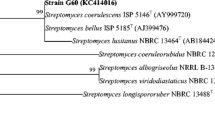Abstract
Recently, there has been increased interest in the preservation of historic monuments, and considerable effort is being employed in developing new methods for controlling weathering, especially biologically influenced deterioration. Increasing our knowledge about the types of organisms growing on facades will help us to prevent undesirable growth on these structures. This report describes isolation and characterization of a halotolerant bacterium isolated from wall scrapings of a historical building. This organism grew well in SM basal salt medium and nitrogen-free semi-solid LGI medium, and tolerated (1) high temperature (up to 55°C), (2) high salt concentration (20%), and (3) a wide range of pH (5.0-12.0). On the basis of its morphological attributes, biochemical characteristics and partial sequencing of 16S rRNA, it belonged to the genus Staphylococcus with 99% identity to Staphylococcus saprophyticus.

Similar content being viewed by others
References
Ausubel FM, Rrent R, Kingston RE, Moore DD, Seidman JG, Smith JA, Struhl K (1987) Current protocol in molecular biology. Wiley, New York
Bravery AF (1988) Biodeterioration of paint - a state-of-the-art comment. In: Houghton DR, Smith RN, Eggins HOW (eds) Biodeterioration. Elsevier, Barking, pp 466–485
Bock E, Sand W (1993) The microbiology of masonry biodeterioration. J Appl Bacteriol 74:503–514
Cavalcante VA, Dobereiner J (1988) A new acid-tolerant nitrogen fixing bacterium associated with sugar cane. Plant Soil 108:23–31
Ciferri O (1999) Microbial degradation of paintings. Appl Environ Microb 65:879–885
Da Silva VQ (2003) Microbial deterioration of paints. Microbiologist 4:43
Gaylarde CC, Gaylarde PM (2005) A comparative study of the major microbial biomass of biofilms on exterior of buildings in Europe and Latin America. Int Biodeterior Biodegrad 55:131–139
Gaylarde CC, Morton LHG (1999) Deteriogenic biofilms on buildings and their control: a review. Biofouling 14:59–74
Graham J, Wilkinson BJ (1992) Staphylococcus aureus osmo- for their possible roles in osmoregulation: role of choline, glycine betaine, proline and taurine. J Bacteriol 174:2711–2716
Griffin PS, Indictor N, Koestler RJ (1991) The biodeterioration of stone: a review of biodeterioration mechanisms, conservation case histories, and treatment. Int Biodeterior 28:187–207
Heyrman J, Swings J (2001) 16S rRNA Sequence analysis of bacterial isolates from biodeteriorated mural paintings in the Servilia tomb (Necropolis of Carmona, Seville, Spain). Syst Appl Microb 24:417–422
Holt JG, Krieg NR, Sneath PHA, Staley JT, Williams ST, Eds (1994) Bergey’s manual of determinative bacteriology, 9th edn., Williams and Wilkins, USA
Incerti C, Blanco-Varela MT, Puertas F, Saiz-Jimenez C (1997) Halotolerant and halophilic bacteria associated to efflorescences in Jerez cathedral. In: Zezza F., Ed., Origin, Mechanisms and Ejects of Salts on Degradation of Monuments in Marine and Continental Environments. Protection and Conservation of the European Cultural Heritage Research, Report No. 4, pp. 225–232
Karpovich-Tate N, Rebrikova NL (1990) Microbial communities on damaged frescoes and building materials in the Cathedral of the Nativity of the Virgin in the Panfnutii-Borovskii Masonry. Russia Int Biodeterior 27:281–296
Kiel G, Gaylarde C (2007) Diversity of salt-tolerant culturable aerobic microorganisms on historic buildings in Southern Brazil. WJ Microbiol Biotechnol 23:363–366
Koestler RJ, Warscheid T, Nieto F (1997) Biodeterioration: risk factors and their management. In: Baer NS, Snegthlage R (eds) Saving our architectural heritage: the conservation of historic stone structures. Wiley, London, pp 25–36
Lindberg T, Granhall U (1984) Isolation and characterization of dinitrogen-fixing bacteria from the rhizosphere of temperate cereals and forage grasses. Appl Environ Microbiol 48:683–689
Loganathan P, Nair S (2004) Swaminathania salitolerants gen. nov., sp. nov., a salt-tolerant, nitrogen-fixing and phosphate-solubilizing bacterium from wild rice (Proteresia corctata Tateoka ). Int J Syst Evol Microbiol 54:1185–1190
Obidi OF, Aboaba OO, Makanjuola MS, Nwachukwu SCU (2009) Microbial evaluation and deterioration of paints and painted-products. J Environ Biol 30:835–840
Rajendrakumar CS, Suryanarayana T, Reddy A (1997) DNA helix destabilization by proline and betaine: possible role in the salinity tolerance process. FEBS Microbiol Lett 410:201–205
Saunders AJ, Davis-Searles PR, Allen DL, Pielak GJ, Erie DA (2000) Osmolyte-induced changes in protein conformational equilibria. Biopolymers 53:293–307
Scott WJ (1953) Water relations of Staphylococcus aureus at 30°C. Aust J Biol Sci 6:549–564
Shirakawa MA, Gaylarde CC, Gaylarde PM, Jonh V, Gambale W (2002) Fungal colonization and succession on newly painted buildings and the effect of biocide. FEMS Microbiol Ecol 39:165–173
Sorlini C, Sacchi M, Ferrari A (1987) Microbiological deterioration of Gambara's frescos exposed to open air in Brescia. Italy Int Biodeterior 23:167–179
Strzelczyk AB (1981) Paintings and sculptures. In: Rose AH (ed) Microbial deterioration. Academic, London, pp 203–234
Tiano P (1993) Biodeterioration of stone monuments: a critical review. In: Garg KL, Garg N, Mukerji KG (eds) Recent advances in biodeterioration and biodegradation, Vol. 1. Naya Prokash, Calcutta, pp 301–321
Tyler ME, Milam JR, Smith RL, Schank SC, Zuberer DA (1979) Isolation of Azospirillum from diverse geographic regions. Can J Microbiol 25:693–697
Acknowledgement
The authors are indebted to Dr. S. S. Kadam, Vice Chancellor, Bharati Vidyapeeth University, Pune, Maharashtra, India, for allowing us to conduct this work at Rajiv Gandhi Institute of IT and Biotechnology, Bharati Vidyapeeth University. The authors are grateful to Mr. Sandip Walunjkar from National Center of Cell Sciences, Pune, for his help in sequencing experiments. We thankfully acknowledge Dr. R.M. Kothari, Principal, Rajiv Gandhi Institute of IT and Biotechnology, for his valuable suggestions.
Author information
Authors and Affiliations
Corresponding author
Rights and permissions
About this article
Cite this article
Jadhav, G., Salunkhe, D., Nerkar, D. et al. Novel Staphylococcus sp. isolated from wall scrapings of a historical building in India. Ann Microbiol 60, 197–201 (2010). https://doi.org/10.1007/s13213-010-0027-2
Received:
Accepted:
Published:
Issue Date:
DOI: https://doi.org/10.1007/s13213-010-0027-2




